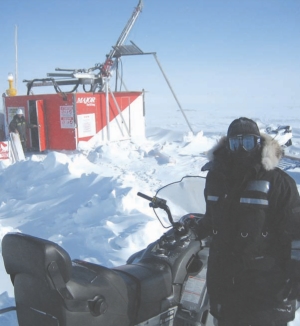VANCOUVER — With two new gold zones at Back River and two expanding deposits at Hackett River, Sabina Gold & Silver (SBB-T) is having a fantastic 2010, evidenced by a share price that has quadrupled since May. Now final results from the company’s considerable summer exploration effort are rolling in and it appears the good news has not stopped yet.
Back River is a gold project in southwest Nunavut, some 520 km northeast of Yellowknife that hosts gold in quartz veins, silicification, and shearing structures within iron formations. Another 50 km to the north is Sabina’s other main project, Hackett River, which is home to four volcanogenic massive sulphide deposits that already support a positive preliminary economic assessment.
With six drills turning between the two projects, Sabina had a busy summer. The company spent $25 million completing some 46,000 metres of drilling and for its work was rewarded with several new discoveries, including two new gold zones and several high-grade intercepts that look set to grow two of the known deposits at Hackett River considerably.
At Back River, Sabina found the new gold zones using its project-specific toolbox. The company had identified the geologic and geophysical signatures that indicate the presence of iron formations with significant alteration and mineralization, which usually occur where the rock has been demagnetized by high-temperature events.
That toolbox led Sabina to the new Umwelt area, which sits 3 km north of the known Goose Lake deposit. Sabina recently punched 54 holes into Umwelt, of which 40 are still being assayed. Results to date have already tracked mineralization along 400 metres strike and to 250 metres depth. Many of the first 14 holes returned visible gold and at depths potentially amenable to open-pit mining.
Mineralization at Umwelt exists within an anti-form structure, with a fold hinge that plunges to the south. The thicker zones of gold mineralization associated with the fold hinge form the East zone. The West zone hosts gold along a separate iron formation horizon immediately to the west.
New results from the East zone include highlight hole 125, which cut 56 metres grading 7.55 grams gold per tonne starting from 63 metres downhole. The hit came 50 metres south of Sabina’s best hole of the season, hole 98, which returned 65.6 metres carrying 10.52 grams gold.
Hole 112, collared 200 metres south of hole 125, intercepted 35.5 metres grading 10.29 grams gold from 191 metres depth. That hit in- cluded 13.5 metres averaging 14.03 grams gold. And hole 81 punched through both zones: it first cut 49.5 metres grading 4.99 grams gold, including 14 metres of 7.11 grams gold, from the East zone and then returned 10 metres of 25.05 grams gold from the West zone.
The other new zone at Back River, known as Llama Lake, is 8 km northwest of the Goose Lake deposit. This summer Sabina completed 61 holes totaling 16,700 metres at Llama and the work defined mineralization along 500 metres strike and to 250 metres depth. Like Umwelt, Llama appears to host a fold structure, with upper and lower iron formations and an interbedded sediment core. The best results from Llama include 7.65 grams gold over 7.2 metres in hole 53, 21.98 grams gold over 6 metres in hole 34, and 11.84 grams gold over 5 metres in hole 54.
“The new discoveries at the Goose property have accelerated the project beyond our expectations,” said Sabina’s president and CEO Tony Walsh. He said the company will spend the upcoming months interpreting results with the goal of completing resource estimates and, if all goes well, will initiate scoping studies in early 2011. Since both new zones still remain open along strike and at depth the company will also plan “a more aggressive program” for next year.
At present, Back River is home to 3.4 million indicated tonnes of 10.9 grams gold plus 3.6 million inferred tonnes averaging 10.2 grams gold.
Sabina also made new discoveries this summer at its more advanced project, Hackett River. In August the company announced the discovery of new massive sulphide and sulphide stringer intersections to the south and west of the East Cleaver deposit as well as hits of new copper stringer mineralization in the immediate footwall of the Main Zone West deposit.
Follow-up drilling at East Cleaver indicates the new zone may be connected to the main zone. For now the new sulphide lens strikes for 100 metres and sits within 200 metres of surface. Results include: 153 metres grading 167 grams silver and 3.75% zinc in hole 53, 51.6 metres carrying 377 grams silver, 3.05% zinc, 2.48% copper, and 1.42 grams gold in hole 56, and 3 metres of 1,604 grams silver and 6.6 grams gold in hole 59. The hits all occur within the proposed open pits.
At Main Zone West, new copper stringer zones have been identified both within and adjacent to the proposed pit outlines, stretching along the zone’s footwall. In the latest set of results, hole 55 cut 157.5 metres grading 0.85% copper while hole 63 returned 128.2 metres of 0.87% copper. Intercepts from the new zones often include high-grade intervals, such as 14.8% copper over 0.45 metre in hole 63.
The best hits from the new zones at East Cleaver’s Main Zone West came from hole 48, which hit 24.4 metres grading 3.56% copper, and hole 41, which returned 17.1 metres carrying 598 grams silver, 22.81% zinc, 2.96% lead and 3.42 grams gold.
The resource at Hackett River currently stands at 43.3 million indicated tonnes grading 4.65% zinc, 144 grams silver, 0.42% copper, 0.64% lead, and 0.3 gram gold, plus 14.6 million inferred tonnes averaging 4.46% zinc, 136 grams silver, 0.31% copper, 0.57% lead, and 0.31 gram gold.
Investors have loved Sabina’s summer results. At the beginning of 2010, the company’s shares were worth roughly $1.25. Since then, Sabina shares have quadrupled, closing recently at $4.50. The company has 134 million shares outstanding.


Be the first to comment on "Sabina rises 260% since May"